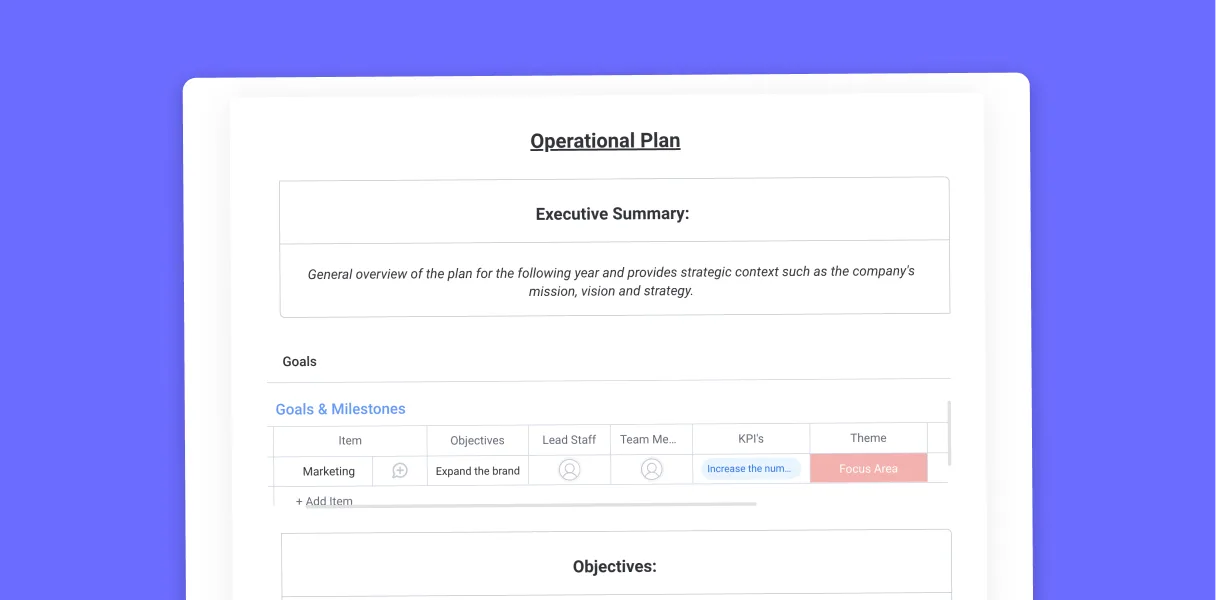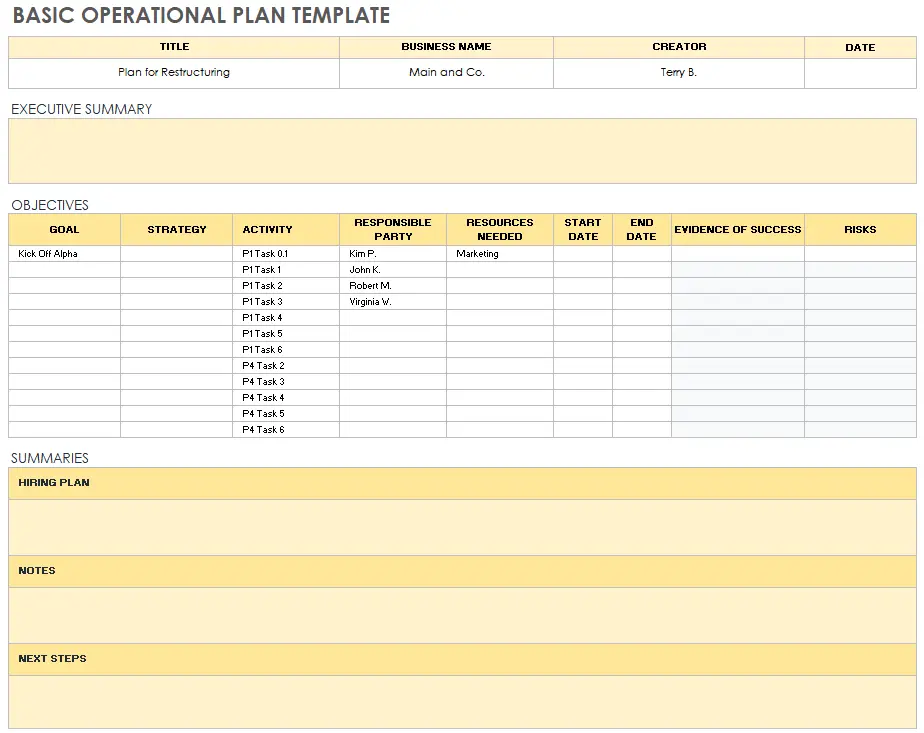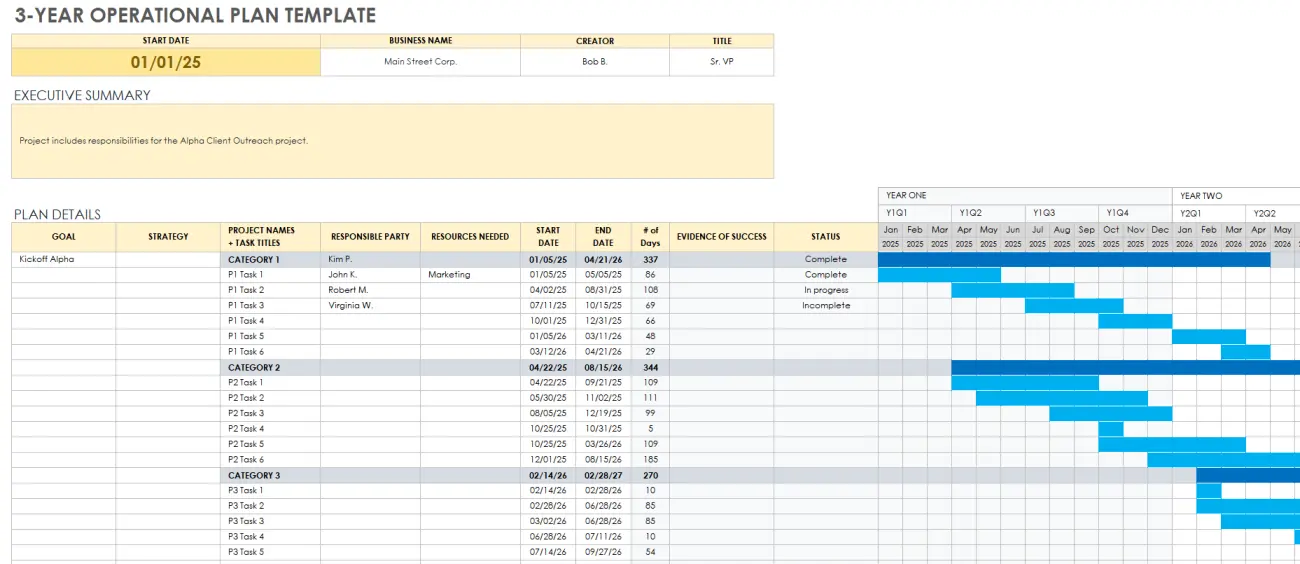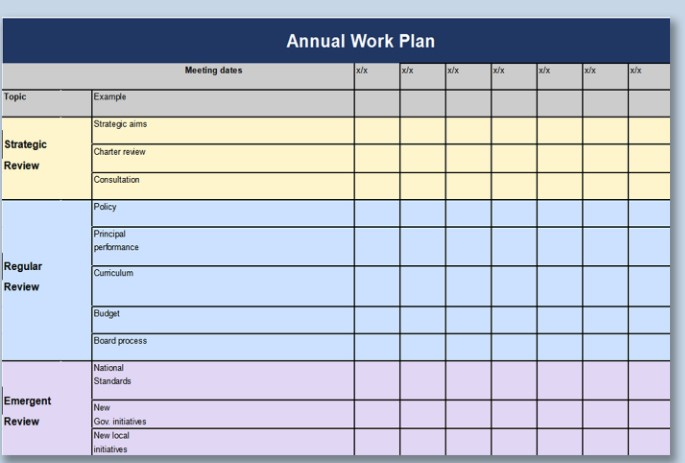
How to Make a Simple Operational Plan Template

Source: Shopify
Building an operational plan became almost indispensable for employees and CEOs to help on getting aligned with the company’s mission and vision. It also helps in choosing the right strategic goals to work on and how to achieve them.
It has several benefits, from helping with strategic plans to capturing key stakeholders for your business to grow. The operational plan template will show how each employee can contribute to achieving these objectives.
What Is an Operational Plan

The operational plan is a document that helps businesses to define their company mission and goals. It also creates detailed instructions to keep all employees on the same page and tell how each can help achieve this objective.
This strategic plan can be used for big and smaller companies. In bigger organizations, it creates outlines for departments and teams. In smaller businesses, though, it is commonly used to assign each employee tasks.
The main objective of the business plan is to connect these assigned tasks to the organization’s goals, giving direction and making them easier to achieve. It is a vital part of strategic planning.
Why Use Operational Plans

Along with defining each person’s role and contribution to achieving goals, there are many other reasons why an operational plan template is essential for your business. The template gives you a transparent look at your company’s daily procedure, including the performance of each department. Doing this, the operational plan can provide the right direction, with clear objectives to help your business get better results and achieve the company’s goals.
The operational plan template can help your business on:
- Defining each employee’s role and responsibilities and track progress of them
- Having detailed instructions on tasks and key initiatives
- Showing how the departments can work together on a bigger objective
- Determining due dates for specific goals and objectives
- Showing the resources needed to achieve the goals and a financial summary
Who Uses the Operational Plan Template
Although everyone contributes to building and executing the operational plans, the document analysis is created for specific people in the company. Three main groups typically analyze the operational plan and track the progress of the company goals.
The three main groups that usually look at and edit the operational plan project details are:
- CEOs
- Operational Leaders
- Operational Teams
Types of Operational Plan Template

There are basically two types of operational plans that you can find in companies. Both have different objectives and will work regardless of your company’s size.
Be sure to analyze each one to decide which is the best option for contributing to your organization’s strategic plan. Here are the main types of operational plans.
Single-Use Operational Plan
The single-use operational plan is usually used for short-term goals and missions that are not directly related to normal operations. This type of operational plan is highly related to business expansion and exploring new markets.
Some examples of single-use operational plans are:
- Expanding the online presence
- Increasing the efficiency of a department
- Offering products online
- Sales numbers milestones

Ongoing Operational Plan
The second type of operational plan template is generally used for long-term goals and objectives. In this case, the operational plan is even more important for showing a clear picture of the necessary resources and tools to use to achieve the planned goals.
It is a document that needs to be constantly updated and analyzed. A well-structured ongoing operational plan can make achieving long-term objectives much more manageable.
How to Create a Simple Operational Plan Template

Now that you know what an operational plan is and what are the most common types, it is time for you to start building your operational plan template. Here we will teach you how to create a simple but effective template that will definitely help you with your business operations and financial projections regarding your goals and objectives.
Identify the Goal or Objective You Want to Achieve
The first thing you need to do on an operational plan template is to decide on the goal you want to reach or the objective you have in mind. The bigger the goal, the more steps you will have to take and the more time and resources you will need.
Also, remember to create a goal that is possible to achieve. It can be challenging but never impossible, especially considering the time you have to complete it.
Analyze the Gap Between the Goal and the Current Situation
After deciding your primary goal, it is time to deeply analyze your company to see where you are now and how far you are from your objective. This will help you better understand the resource needs and the time frames that you will be working with.
The main reason for doing all this is to formulate a better strategic plan for achieving the goal. After knowing everything that may prevent your organization from achieving its goal, it becomes easier to work on these gaps.

Choose the Areas You Need to Focus On
After analyzing the gap and seeing the main points preventing you from achieving the goal, you must choose which areas to focus on. Based on these points, you will decide the strategic priorities of your operational plan template.
The most common way of doing this is by organizing the business sections from a department perspective. Here are the main departments that operational teams focus on when creating an operational plan template:
- IT
- Sales
- Logistic
- Administration
- Technology
- Human Resources
Write Your Strategic Objectives
The strategic objectives of your operational plan template are like “mini goals.” They are tasks and objectives that, once completed, get you closer to your main goal.
They are an indispensable part of the operational plan and must be carefully chosen. Creating too many strategic objectives can become a problem. They need to be made only for significant accomplishments to show real growth in the business.
The strategic objectives are the path that needs to be followed to reach your objective. These mini-goals must be well-thought-out to fill your business needs before accomplishing the primary goal.

Create Milestones
Milestones and Strategic objectives may look like the same thing, but they are entirely different. The strategic objectives are tasks that, once accomplished, get you closer to your goal.
Milestones are specific points on the business plan template created to track the progress of the project you are working on, in this case, the main objective. The milestones also work as a tool for employees to see that their actions impact the business. Moreover, it is a great way to keep people motivated and doing a good job.
Key Assumptions and Risk Assessment
This part of the operational plan template is created for the operation team to list all the risks and situations your organization may face along the project. It is a way of anticipating problems and better understanding strategies to counter them in the future. When well done, this part can be a true savior for the company and help in saving resources.

Choose Your Key Performance Indicators
The next step of your operational plan is to choose the proper KPIs for your goal. They also need to be strategically selected for the business plan template to be effective.
The KPIs can go from growth in sales numbers to any other category that puts your results to prove and attest to the growth in the quality standards of your organization. The main objective of this tool is to evaluate the impacts on your organization once the goal is accomplished.
Keep It Constantly Updated
The last step of your operational plan template is to keep it continuously updated. The team must agree to update any changes or task statuses as soon as possible for a clearer result of the team’s performance.
Along with that, keeping the business plan template updated also helps avoid unexpected problems. From informed decisions to new tasks, a fresh operational plan can be a total game changer for the organization.
Where to Create Operational Plan Templates

There are many options when it comes to creating operational plan templates – from specialized tools to general software capable of making the perfect customizable template. Everything will depend on the needs of your organization.
For creating an operational plan template, we highly recommend using Microsoft Excel. The program has one of the best tool sets of all software available and can create the perfect template for your business regardless of your needs.
Additionally, Excel is an industry-standard with features that go far beyond just creating an operational plan. With Microsoft Office, you can create almost any document your business needs, from an executive summary to a hiring plan.
If you don’t have a Microsoft Office activation key, you can buy one at RoyalCDKeys for a considerably lower price when compared to Microsoft Store. This way, you save money that you can use for other parts of your business.
Ready to Use Templates
If you don’t want to create your operational plan template from scratch, there is no problem. Here are some popular templates you can download and edit to better fit your necessities. Be sure to choose a template that truly fits your needs and objectives. This way, you will end up with a document that will effectively impact your business and help with your goals.
Template #1

Basic operational plan template. Perfect for any size and type of business.
Template #2

3-year operational plan template. Uses a timeline for projects expected to be completed within 3 years.
Template #3

Annual operational plan template. Indicated for projects that are expected to last less than 12 months to be completed.
Conclusion on Operational Plans
The operational plan template is one of the best tools to help your business to achieve the desired results and goals in the most efficient way possible. Although it may look hard, it is pretty straightforward once you understand the process.
Remember that for the document to be effective, you must carefully choose the details like milestones and strategic objectives. Lastly, don’t forget to update it constantly.
This step is indispensable for the operational plan to reflect the project's current state. Moreover, forgetting to update it can directly affect the tool's performance.
Now that you know everything about operational plans, it is time to start creating your template. Don’t forget to analyze your business and create a template that fits your expectations and needs. By doing this, you will definitely be able to achieve all the desired results.















